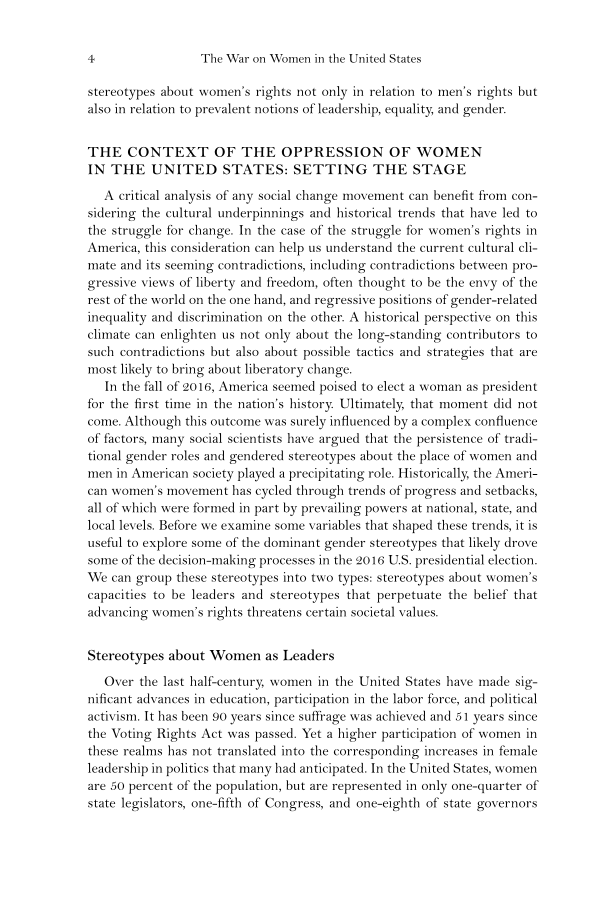4 The War on Women in the United States stereotypes about women’s rights not only in relation to men’s rights but also in relation to prevalent notions of leadership, equality, and gender. THE CONTEXT OF THE OPPRESSION OF WOMEN IN THE UNITED STATES: SETTING THE STAGE A critical analysis of any social change movement can benefi t from con- sidering the cultural underpinnings and historical trends that have led to the struggle for change. In the case of the struggle for women’s rights in America, this consideration can help us understand the current cultural cli- mate and its seeming contradictions, including contradictions between pro- gressive views of liberty and freedom, often thought to be the envy of the rest of the world on the one hand, and regressive positions of gender-related inequality and discrimination on the other. A historical perspective on this climate can enlighten us not only about the long-standing contributors to such contradictions but also about possible tactics and strategies that are most likely to bring about liberatory change. In the fall of 2016, America seemed poised to elect a woman as president for the fi rst time in the nation’s history. Ultimately, that moment did not come. Although this outcome was surely infl uenced by a complex confl uence of factors, many social scientists have argued that the persistence of tradi- tional gender roles and gendered stereotypes about the place of women and men in American society played a precipitating role. Historically, the Ameri- can women’s movement has cycled through trends of progress and setbacks, all of which were formed in part by prevailing powers at national, state, and local levels. Before we examine some variables that shaped these trends, it is useful to explore some of the dominant gender stereotypes that likely drove some of the decision-making processes in the 2016 U.S. presidential election. We can group these stereotypes into two types: stereotypes about women’s capacities to be leaders and stereotypes that perpetuate the belief that advancing women’s rights threatens certain societal values. Stereotypes about Women as Leaders Over the last half-century, women in the United States have made sig- nifi cant advances in education, participation in the labor force, and political activism. It has been 90 years since suffrage was achieved and 51 years since the Voting Rights Act was passed. Yet a higher participation of women in these realms has not translated into the corresponding increases in female leadership in politics that many had anticipated. In the United States, women are 50 percent of the population, but are represented in only one-quarter of state legislators, one-fi fth of Congress, and one-eighth of state governors
Document Details My Account Print multiple pages
Print
You have printed 0 times in the last 24 hours.
Your print count will reset on at .
You may print 0 more time(s) before then.
You may print a maximum of 0 pages at a time.














































































































































































































































































































